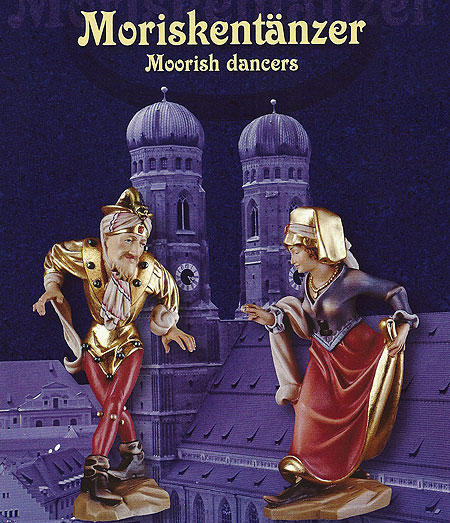Moriskentänzer

Die Moriskentänzer wurden im Jahre 1477 für
den Tanzsaal des Rathauses der Stadt München geschnitzt. Dieser
Tanzsaal hatte die vielfältigsten Repräsentationsaufgaben der Stadt zu
erfüllen. Die Figuren stammen aus der Hand Erasmus Grasser`s, der 1450 in
Schmidmühlen bei Burglengenfeld geboren, um das Jahr 1475 nach München kam.
Trotz des Einspruchs der Zunft, brachte es Grasser sehr bald zum Meister und
wurde schon 1476 beauftragt das neue Münchener Stadtwappen zu schaffen. Als
Grasser 1477 anfing mit den Moriskentänzern, war das neue Münchner Rathaus,
erbaut. von Joerg von Habbach in der Jahren 1470- 1474, gerade fertig
geworden. Grasser schuf 16 Figuren, von denen heute noch 10 erhalten sind.
Die Moriskentänzer verkörpern eine Tanzart, die nicht auf deutschen Boden
entstanden ist. Man schreibt sie den Morisken zu, den Abkömmlingen der
spanischen Mauren. Der Tanz kam von dort über Frankreich und England nach
Deutschland und hat sich nachweislich große Beliebtheit erfreut. Im
Mittelpunkt stand eine Frau - als Glücksgöttin oder Maienkönigin- die als
Preis einen Apfel oder Ring und damit sich selbst darbot. Zum Geleit des
begehrenswerten, weiblichen Wesens gehörten ein Narr sowie Musikanten. Und
gerade diese Figuren sind im Laufe der Zeit abhanden gekommen. Der Tanz
verrät Lebenslust, Energie, Schwung und Leichtigkeit. Die geschmeidige Kraft
der Tänzer äußert sich in den verschiedenen Möglichkeiten sich auszudrücken:
verzückt, ekstatisch und urwüchsig und stellt in den individuellen
Erscheinungsformen der einzelnen Tänzer auch die verschiedenen Typen der
Städter und Bauern dar. Der Tanz ist bis heute erhalten geblieben. Grasser
erhielt für die 16 Figuren seinerzeit 172 rheinische Gulden, damals ein
Vermögen. Unsere Tänzer sind nach den Originalen von Erasmus Grasser frei
nachgebildet und stellen unterschiedliche kecke, verbissene oder schüchterne
Charaktere von Gauklern, Akrobaten und Musikanten dar.
Moriskentänzer nach Erasmus Grasser